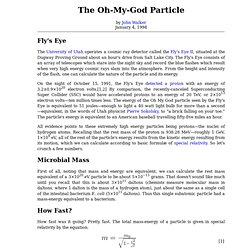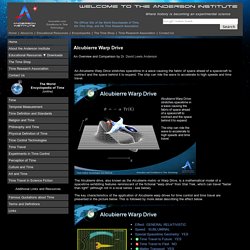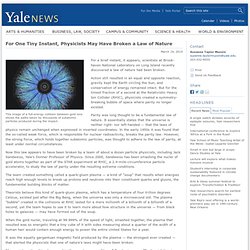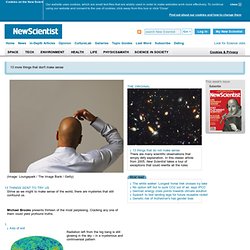

The Oh-My-God Particle. By John Walker January 4, 1994 Fly's Eye The University of Utah operates a cosmic ray detector called the Fly's Eye II, situated at the Dugway Proving Ground about an hour's drive from Salt Lake City.

The Fly's Eye consists of an array of telescopes which stare into the night sky and record the blue flashes which result when very high energy cosmic rays slam into the atmosphere. From the height and intensity of the flash, one can calculate the nature of the particle and its energy. On the night of October 15, 1991, the Fly's Eye detected a proton with an energy of 3.2±0.9×1020 electron volts.[1,2] By comparison, the recently-canceled Superconducting Super Collider (SSC) would have accelerated protons to an energy of 20 TeV, or 2×1013 electron volts—ten million times less.
All evidence points to these extremely high energy particles being protons—the nuclei of hydrogen atoms. Microbial Mass How Fast? How fast was it going? And thus, approximately: v = 0.9999999999999999999999951 c Quicktime. Alcubierre Warp Drive Time Travel. An Alcubierre Warp Drive stretches spacetime in a wave causing the fabric of space ahead of a spacecraft to contract and the space behind it to expand.

The ship can ride the wave to accelerate to high speeds and time travel. The Alcubierre drive, also known as the Alcubierre metric or Warp Drive, is a mathematical model of a spacetime exhibiting features reminiscent of the fictional "warp drive" from Star Trek, which can travel "faster than light" (although not in a local sense - see below). The key characteristics of the application of Alcubierre warp drives for time control and time travel are presented in the picture below.
This is followed by more detail describing the effect below. Alcubierre Warp Drive Description In 1994, the Mexican physicist Miguel Alcubierre proposed a method of stretching space in a wave which would in theory cause the fabric of space ahead of a spacecraft to contract and the space behind it to expand. Alcubierre Metric. Imagining the Tenth Dimension - A Book by Rob Bryanton. For One Tiny Instant, Physicists May Have Broken a Law of Nature. This image of a full-energy collision between gold ions shows the paths taken by thousands of subatomic particles produced during the impact.

For a brief instant, it appears, scientists at Brookhaven National Laboratory on Long Island recently discovered a law of nature had been broken. Action still resulted in an equal and opposite reaction, gravity kept the Earth circling the Sun, and conservation of energy remained intact. But for the tiniest fraction of a second at the Relativistic Heavy Ion Collider (RHIC), physicists created a symmetry-breaking bubble of space where parity no longer existed. Parity was long thought to be a fundamental law of nature. It essentially states that the universe is neither right- nor left-handed — that the laws of physics remain unchanged when expressed in inverted coordinates.
Now this law appears to have been broken by a team of about a dozen particle physicists, including Jack Sandweiss, Yale's Donner Professor of Physics. . — By Suzanne Taylor Muzzin. 13 more things that don't make sense. Cookies on the New Scientist website close Our website uses cookies, which are small text files that are widely used in order to make websites work more effectively.

To continue using our website and consent to the use of cookies, click away from this box or click 'Close' Find out about our cookies and how to change them Log in Your login is case sensitive I have forgotten my password close My New Scientist Look for Science Jobs 13 more things that don't make sense (Image: Loungepark / The Image Bank / Getty) Strive as we might to make sense of the world, there are mysteries that still confound us.
Axis of evil Radiation left from the big bang is still glowing in the sky – in a mysterious and controversial pattern Dark flow Something unseeable and far bigger than anything in the known universe is hauling a group of galaxies towards it at inexplicable speed Eocene hothouse Tens of millions of years ago, the average temperature at the poles was 15 or 20 °C. Fly-by anomalies Hybrid life.